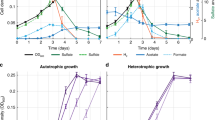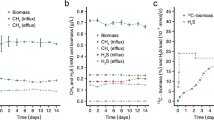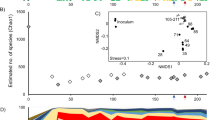Abstract
Two processes are known whereby energy is conserved during substrate metabolism in heterotrophic organisms: respiration and fermentation. Both involve oxidation–reduction reactions; but whereas in respiration the electrons are transferred from substrate to an electron acceptor, in fermentation part of the substrate molecule itself accepts the electrons. Fermentation is therefore a type of disproportionation, and does not involve an overall change in oxidation state of the substrate. All fermentative substrates known to date are organic molecules. We have discovered a novel type of fermentation involving the disproportionation of inorganic sulphur compounds in certain sulphate-reducing bacteria1. Initially discovered in a newly isolated sulphate-reducing bacterium, Desulfovibrio sulfodismutans, the capacity for disproportionation of sulphur compounds is also found in some known sulphate-reducing bacteria and various bacteria isolated from freshwater, brackish or marine sediments.
This is a preview of subscription content, access via your institution
Access options
Subscribe to this journal
Receive 51 print issues and online access
$199.00 per year
only $3.90 per issue
Buy this article
- Purchase on Springer Link
- Instant access to full article PDF
Prices may be subject to local taxes which are calculated during checkout
Similar content being viewed by others
References
Postgate, J. R. The Sulphate-reducing Bacteria 2nd edn (Cambridge University Press, 1984).
Widdel, F. & Pfennig, N. Arch. Microbiol. 129, 395–400 (1981).
Schmidt, M. in Sulfur, its Significance for Chemistry, for the Geo, Bio and Technosphere and Technology (eds Müller, A. & Krebs, B.) 259–276 (Elsevier, Amsterdam, 1984).
Belkin, S., Wirsen, C. O. & Jannasch, H. W. Appl. Environ. Microbiol. 49, 1057–1061 (1985).
Bak, F. & Pfennig, N. Arch. Microbiol. (in the press).
Kelly, D. P. Phil. Trans. R. Soc. P298, 499–528 (1982).
Trüper, H. G. Phil. Trans. R. Soc. B298, 529–542 (1982).
Cypionka, H. & Pfennig, N. Arch. Microbiol. 143, 396–399 (1986).
Thauer, R. K., Jungermann, K. & Decker, K. Bact. Rev. 41, 100–180 (1977).
Author information
Authors and Affiliations
Rights and permissions
About this article
Cite this article
Bak, F., Cypionka, H. A novel type of energy metabolism involving fermentation of inorganic sulphur compounds. Nature 326, 891–892 (1987). https://doi.org/10.1038/326891a0
Received:
Accepted:
Published:
Issue Date:
DOI: https://doi.org/10.1038/326891a0
This article is cited by
-
Geochemical transformations of sulfur and their role in the formation of different types and subtypes of saline lakes in Southeastern Transbaikalia
Applied Water Science (2024)
-
Microbially-enriched poultry litter-derived biochar for the treatment of acid mine drainage
Archives of Microbiology (2018)
-
Annual sulfur cycle in a warm monomictic lake with sub-millimolar sulfate concentrations
Geochemical Transactions (2015)
-
Niche differentiation of bacterial communities at a millimeter scale in Shark Bay microbial mats
Scientific Reports (2015)
-
Disproportionation of elemental sulfur by haloalkaliphilic bacteria from soda lakes
Extremophiles (2013)
Comments
By submitting a comment you agree to abide by our Terms and Community Guidelines. If you find something abusive or that does not comply with our terms or guidelines please flag it as inappropriate.



